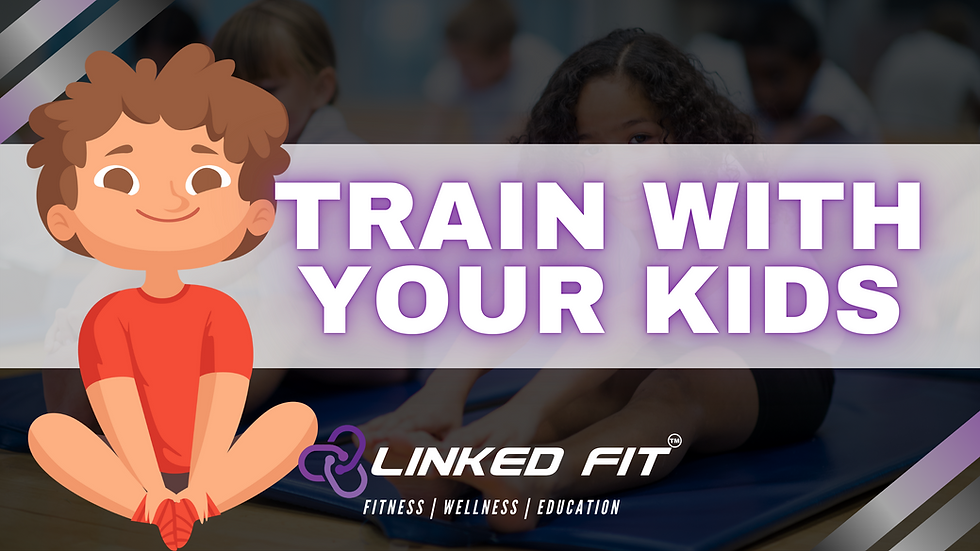Five Common Training Errors
- Linked Fit

- Feb 6, 2021
- 5 min read
Updated: Apr 24, 2021

A training session should be carefully structured from an organized program. Each component of the training session needs to have a transferable benefit that ultimately advances assurance of the performance desired. In the world of programming, a variety of methods can be integrated to produce optimal adaptations, but it’s using a system that has been supported to work is the key consideration.
This article will focus on the five common training errors that individuals are likely to practice while participating in a fitness and wellness journey. After reading this article, individuals will be able to tweak their training sessions and program to achieve their targeted goals. These five errors are commonly performed and a variety of professional coaches recognize these matters as detrimental towards any training objective.
1. Insufficient Warm-Up
First things first, a treadmill run is not the best way to prepare the body for a training session! Let’s say it again, a treadmill run is not the best way to prepare the body for a training session! It definitely can be “included” in the warm-up to produce general movement, but it should not be the only thing.
In order to optimize movement for the training session, the warm-up should be focused on preparing the body for the upcoming demands. The demand is real and should be addressed as a phased sequence to prioritize the opportunities of local and global return.
You may ask, what is a local and global return? Our body is uniquely made up of a variety of organs that come together to operate life. Each organ system supports a function that needs to be provided to keep the body running smoothly. When we examine the body through a local lens, the body has some very deep muscles that are usually small in nature but provide a great effort in stabilizing the joints through movement. Additionally, the global muscles are the ones that are large and more superficial. These muscles are largely considered to be the most demanding when it comes to movement as a whole. At times, our bodies tend to get in a funk. A funk from postural distortions, lack of healing from injuries, repetitive motions, or growth errors that produce faults in the kinetic chain. Therefore, an OPTIMAL PREPARATION procedure to help correct their ramifications and improve the quality of movement for the session is needed.
Preparation
Massage
Flexibility
Mobility
Stability
Foundation
Activation
The videos below will demonstrate what is a GREAT way to warm-up for a total push day which includes squatting and overhead pressing.
Massage: Hypervolt ½ Kneel Hip Flexor
60 seconds - each side
Flexibility: ½ Kneel Quad Stretch (Rear Foot Elevated)
x60 seconds - each side
Mobility: Alt Groiner
x30 seconds
Low Pillar Bridge w/ KB Sliding Push/Pull
x15 seconds - each arm
Bodyweight Squat
3x5 repetitions
MB OH Slam
5x5 repetitions
2. Fixed Repetitions & Sets
A fixed concept will only get you so far! The body is pretty damn good at adapting with the intent to overcome the rigors of the once delivered stressors. With that said, the continued efforts to perform 3 sets of 10 repetitions are erroneous and misguided.

The body needs the opportunity to overcome new volumes that push the body to new limits. These volumes can be created in an undulating fashion to trigger change. You may ask, do I keep changing my training routine to new repetitions and sets with every session? No, not necessarily! Think about a plan, a plan of action that will continue to challenge you but has mixed weeks of changed programming.
Example: Perform 4 sets of 8 repetitions for a few weeks of one particular movement in the routine, but after a few weeks, CHANGE IT UP! Change it to 5 sets of 6 repetitions.
3. Lack of Intensity
Oh… yes, the lack of intensity is very common and could have been the first thing discussed in this article. However, everyone should warm-up first before training so it was noted as the first one.
In any training session, many individuals keep the same intensity with the lack of a true upgrade. This upgrade is an absolute breach of one’s comfort zone, but keeping movement quality high and staying safe, will help improve the compositions of the body. There are a variety of ways to monitor one’s intensity. Here are two recommendations to utilize an intensity check: rate of perceived exertion (RPE) or heart rate (HR). When it comes to using the RPE method of intensity monitoring, it’s as simple as stating a 1 to 10 rating (1 = Low; 10 = Maximum). If someone rates themselves as a 10 out of 10, they should be pretty damn exhausted after because it took a lot out of them to complete those repetitions or particular movements. Another way is simply using the heart rate with using your age as an indication. However, this way is very subjective from person to person due to current fitness and health statuses.

220 – AGE = Max Heart Rate
85% of Max Heart Rate = Max Heart Rate x 0.85
65% of Max Heart Rate = Max Heart Rate x 0.65
In the end, everyone will be different when it comes to intensity variations and knowing when it’s okay to progress. However, just don’t be scared to increase the intensity!
4. Disorganized Training
In most cases, individuals walk into a training session with no real goal or rationale of what they want to focus on. This is what we call “Disorganized Training”!

We are BIG believers in having a purpose for each portion of the training session from the Preparation, Primary, Key Performance Indicator (KPI), Blocks, Conditioning, and Recovery. The training session should revolve around the KPI! You plan on hitting the squat movement pretty hard with some intensity, well… PREPARE FOR IT and PRIME IT FURTHER for true kinetic linking.
If someone has an organized training program, it allows them to understand the purpose of the session with the overall end goal in mind. You may have heard of SMART goals, well it takes a specific, measurable, achievable, realistic, and timely plan to get to that goal. An organized training program includes all of these concepts: specific, measurable, achievable, realistic, and timely. Really think about your end goal and how you plan to achieve it. Organize a plan of action to achieve the goal!
5. Poor Recovery
At Linked Fit, recovery is the HUGE focus!
Without the protocols of optimal recovery, the body has a hard time adapting and growing. When participating in a training routine, the recovery SHOULD NOT be forfeited. Review each protocol such as pre-training, during-training, post-training, and after training to enhance recovery. Recovery is more than grabbing a foam roller and protein shake. The details shouldn't be missed so fatigue can be managed.

Additionally, other links need to be considered when it comes to superior regeneration. Check out our article “Recovery Cycle” (Click Here) to learn more about what these links are and what we recommend to improve them. This article provides more information about health, stress, nutrition, sleep, and training within the relations towards superior recovery.





Comments